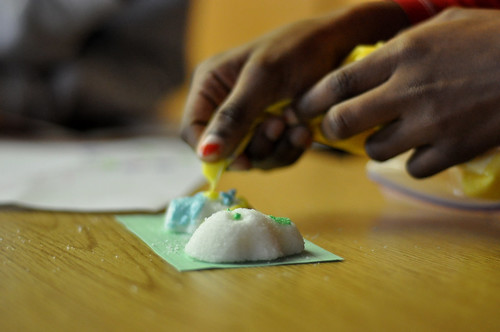Here are some of the things I have done with my students in the past, and some things that will be included in my lesson plans for this week.
Let students explore some of the sights and sounds of the holiday.

I love the opportunity to hook students with something mysterious. As a traveling elementary teacher, in past years I have put together a mini portable altar in a wooden cigar box, with a picture of Frida Kahlo (a favorite figure that most of my students learn about at some point in their time with me.) I light the "altar" with battery operated candles, and the flicker of yellow light from inside a closed box gets everyone's attention. Usually I extend the suspense and leave the box closed until we have explored some resources together, and then I will invite students to gather around and look at what is inside the box (photos, candles, flowers, sugar skulls... all things they just saw in a book or video.)
As far as what resources to use with students, there are so many great options. I have used books with younger classes, but I have also gathered several online videos and articles for the diverse grades I have worked with. I usually start with this touching animated short, which students have enjoyed in kindergarten and in 8th grade alike. (The kindergartners also are big fans of the skeleton dance.) Depending on the age and how much time we have, I also try to have a variety of readings for students to get a little more in-depth look at the history of the celebration.
If you are looking for something appropriate for your students, take a look through my resource pile below. Resources and links are categorized by learning style, grade level, and language skills. I've included some higher level Spanish texts for native speakers, like the fantastic Veinte Mundos magazine. Until today I had never heard of the Bolivian tradition of the Ñatitas. It might be a bit too much for my middle school students, and I am not quite sure of my new school's tolerance for images of human remains, no matter how stylishly and lovingly they have been costumed. (Maybe those of you with older students can use this in your classes. It's a fascinating way to highlight a mixture of Catholic and native traditions, and the tensions that can arise. Also, people carrying human skulls around is even more attention-grabbing than a battery operated candle.)
Build relationships and cultivate respect for dramatically different viewpoints.
I focus my Día de los Muertos lessons on comparing and contrasting the traditions we explore with those in the lives of my students. As students learn about the holiday from videos or readings, they take notes on a visual checklist, and then we compare what they have observed with their own experiences.
 |
| We use this chart to predict what you might see during Día de los Muertos celebrations - and what you might not! |
Cultural and especially religious traditions can become controversial in the classroom, and as a language teacher this is when I often find myself explaining and defending the the role of cultural lessons in a language classroom. I am careful to emphasize to students and parents that we can learn about holidays without celebrating them. In the past I have had one parent request that their child do research on an alternate tradition, but in general I feel that this is a valuable opportunity for dialog.
Besides the rich sensory and cultural aspects of this holiday, there are a lot of personal connections to be made. This holiday comes early in the school year, but not too early - so sometimes students are willing to open up and share the ways that they remember loved ones. I like to think that the joyfulness of the Mexican holiday balances what could otherwise be a somber theme.
It's an excuse for some hands-on crafts.
As a second year teacher, I was thrilled to finally have my own classroom so I could make sugar skulls with my classes. I got supplies and decided to undertake the project just with a few middle school classes. The kids loved it, but I imagine that my successor is still finding frosting on improbable surfaces of the building. I did make sugar skulls again last year with my Spanish Club, but I don't know if it is going to happen this year. It can be a tedious project, and sometimes the hardest part is convincing students not to eat the final project.


Even as a traveling teacher, I do still make calavera masks with my students. They are not as impressive as sugar skulls, but they certainly take up less time (and sanity) and are simple enough to give directions just in Spanish. I have used the mask template from AZ Central's Teacher Packet for years. Usually I have this as an optional activity for students who finish up their culture journals. (Big kids love coloring, too.)

No comments:
Post a Comment